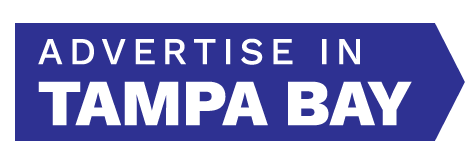The combined weekly reach of Tampa Bay's broadcast television stations has slipped to 66.2% of all adults, according to Nielsen. These stations include WFLA, WTSP, WTVT, WFTS, WEDU, and WFXT.
The combined Tampa Bay TV audience now falls behind cable programming at 76.6% and streaming platforms at 66.3%. To put this virtual dead heat into perspective, none of the three video media is a match for Tampa Bay radio which reaches more than 84.4% of local adults every week.
But although the reach of broadcast TV, cable, and streaming are neck-and-neck, the share of time consumers spend with each of these media is dramatically different.
Read More
Topics
TV,
Television,
Cable TV,
Television Advertising,
Streaming,
pay-tv,
OTT,
CTV,
streaming video,
avod,
svod,
local television,
streaming television,
streaming media,
streaming TV
According to Nielsen research, 1.8 million people in the Tampa Bay area will likely participate in the upcoming election on November 8th. To sway these voters, candidates and political action committees are expected to spend a record amount on advertising.
AdImpact, a company that measures advertising expenditures by political campaigns, says more than $3.6 billion have been spent to reach voters so far in 2022. This puts spending on a course to obliterate the record level of campaign dollars set during the 2020 presidential elections.
Despite crumbling ratings, through August 1st, 58% of all political spending has been dished out to local TV stations, according to AdImpact.
Nielsen reports that since 2017, the reach of broadcast TV stations like WFLA, WTSP, WTVT, WFTS, and WEDU has decayed by 10%.
Read More
Topics
Television,
Television Advertising,
digital advertising,
online advertising,
politcial advertising,
political advertising,
political rates,
political rate card,
OTT,
CTV,
streaming video,
avod,
svod,
internet,
local television,
streaming television,
internet advertising,
streaming media,
streaming TV
During the past seven days. according to Nielsen, only 67.1% of local consumers tuned in to Tampa television stations like WFLA, WTSP, WTVT, WFTS, WEDU, or WFXT. TV's diminishing reach among adults 18 and older has been eclipsed by the audience size for social media, cable, and Tampa radio. Furthermore, streaming video services such as Netflix, Hulu, Prime, and Disney+ are quickly reaching parity with over-the-air options.
The erosion of local TV station audiences is stunning when comparing prime-time ratings from the past. In 1980, the highest-ranked TV show was Cheers with a 21.3 rating. The 30th-ranked show was The Wonder Years with a 14.2 rating.
Twenty years later, Survivor was the number one show with a 17.4 rating and Family Law was the 30th ranked show with an 8.8 rating.
Finally, in 2019, Sunday Night Football was the number one ranked show with a 10.9 rating. Survivor tied with Dancing With The Stars in 30th place with a 5.5 rating.
It is stunning to think that the number one TV show in 2019 had a 24% lower rating than the 30th-ranked show in 1980.
Read More
Topics
TV,
Television,
small business,
small business owner,
Cable TV,
Television Advertising,
best way to advertise,
tampa small business owners,
small business advertising,
pay-tv,
direcTv,
small business marketing,
satellite TV,
OTT,
CTV,
avod,
svod,
local television,
streaming TV
Right now, at least one of the 128,637 businesses located in the Tampa Bay area is thinking about using the phrase 'March Madness' as part of upcoming advertising and marketing plans. Why not? It's a great use of alliteration. It's a familiar term. And, it's that time of year.
A furniture store in Clearwater might think it would be clever to use 'March Madness' in its commercials on Tampa radio to promote a big spring sale. A non-profit in St. Petersburg feels it would be a good way to describe its charity fun run on social media and online advertising. A sports bar in Brandon believes it would be a no-brainer to use the term in streaming video and audio ads to bring in scores of basketball fans.
It is, indeed, tempting for a Tampa Bay small business owner to use this term for advertising or marketing purposes. But, to avoid a costly legal battle, the use of this trademarked phrase should be a non-starter. Here's why.
Read More
Topics
Television Advertising,
Streaming,
Streaming Audio,
radio advertising,
digital advertising,
online advertising,
social media advertising,
OTT,
CTV,
streaming video,
streaming television,
internet advertising,
streaming media,
streaming TV,
search engine marketing,
sem,
display advertising,
intellectual property,
trademark,
copyright
Every week, 1.7 million Tampa Bay adults watch video programs delivered via the internet. This content goes by several interchangeable names, including OTT (Over-The-Top Television), CTV (Connected TV), and Streaming Video. For this article, we will refer to this type of content as Streaming TV.
Unlike traditional TV, cable, and satellite where the viewer needs to be in a fixed location, Tampa Bay consumers can access streaming TV anywhere using an internet-connected device. These include SmartTVs, Firesticks, Roku, smartphones, computers, laptops, tablets, and gaming consoles.
In all, according to Nielsen, 95.2% of Tampa Bay households have one or more devices capable of connecting to streaming TV. Although this medium is still new, streaming TV now rivals legacy media in its ability to reach local consumers.
Every week, Tampa Bay consumers are spending more-and-more time engaged with streaming TV.
Read More
Topics
Cable TV,
Television Advertising,
Streaming,
digital advertising,
online advertising,
OTT,
CTV,
streaming video,
avod,
svod,
advertising options,
streaming television,
internet advertising,
streaming media,
streaming TV
Tampa Bay area business owners are expected to spend $1-billion advertising online in 2022. This, according to Borrell Associates, a company that tracks advertising expenditures across the country.
Borrell's forecast indicates that almost 50% of Tampa Bay's online expenditures will be in the form of paid search. The most recognizable type of this advertising is the paid ads that appear adjacent to the results of almost every search query on Google, Yahoo, and Bing.
Borrell's forecast also indicates that approximately 27% of online expenditures will be in the form of display advertising. This consists of traditional banner ads that appear across millions of websites and apps, including social media platforms like Facebook and Instagram. According to SmallBizGenius.net, the average Tampa Bay area consumer is served more than 1700 of these ads per month.
Video advertising in Tampa Bay is forecast to account for 21% of all online ad dollars in 2022. Like search and display, millions of websites can support this type of advertising. This includes sites, apps, and platforms like YouTube, Roku Channel, Hulu, Paramount+, and most social media sites.
The remainder of online advertising dollars is expected to be spent on audio advertising, including streaming sites like Pandora and Spotify; or email marketing campaigns.
Read More
Topics
Streaming,
Streaming Audio,
digital advertising,
online advertising,
social media advertising,
millennial parents,
borrell associates,
social media,
OTT,
streaming video,
ad spending,
advertising options,
streaming television,
internet advertising,
streaming media,
streaming TV,
search engine marketing,
sem
It wasn't too long ago when advertising on Tampa Bay television stations was considered the gold standard for marketing by local business owners. But over the past few years, the number of viewers reached by WFLA, WTSP, WTVT, WFTS, and WEDU has plummeted. In all only 67% of adult consumers now tune-in to at least one of these channels during the week, according to Nielsen.
The consumption of video content isn't diminishing among Tampa Bay consumers. What has changed, though, is how they are watching it.
In November, according to Nielsen, the share of time watching broadcast television has fallen behind other video options including cable programing and internet-delivered choices such as Netflix, Hulu, Disney+, and hundreds of other streaming networks.
Read More
Topics
TV,
Television,
Cable TV,
Television Advertising,
pay-tv,
satellite TV,
OTT,
CTV,
streaming video,
avod,
svod,
local television,
streaming television,
streaming media,
streaming TV
It used to be so simple. When a small business owner wanted to advertise on Tampa television, there were only a few options including, WFLA, WTSP, WTVT, WFTS, and WEDU. But slowly, the number of options expanded to include cable channels provided by Xfinity, DISH, DirecTV, and Spectrum.
Heading in 2022, local advertisers have even more options as internet-connected devices deliver hundreds of more programming choices to Western Florida consumers. Collectively, this type of content is called OTT (Over-The-Top-Television) or CTV (Connected-Television). For the purpose of this discussion, OTT & CTV will be referred to singularly as streaming video.
Streaming video can be viewed on any device that can connect to the internet. This includes computers, laptops, tablets, and smartphones. Programing can also be accessed using a smart-TV, Roku Stick, Amazon Fire Stick, or a game console. In all, according to Nielsen, 95.2% of Tampa Bay households own a device capable of receiving streaming video.
In all, says Nielsen, 1.7 million consumers watch streaming video content every week. Combined, these internet channels now reach more adults every week than local newspapers, podcasts, and digital audio services like Pandora, Spotify, Sirius/XM. Amazon Music, and iHeart Radio.
Surprisingly, streaming video now reaches almost as many adults as local TV and local cable.
Read More
Topics
Cable TV,
Television Advertising,
digital advertising,
online advertising,
pay-tv,
OTT,
CTV,
streaming video,
internet,
local television,
internet advertising,
streaming media,
streaming TV
Every week, according to Nielsen, 2.5 million adult consumers in Tampa Bay watch something on television. But, of course, the definition of what it means to watch TV has changed since the time when the number of available viewing options could be counted on the fingers of a single hand.
Today, Tampa Bay consumers have a gargantuan number of viewing choices. This includes programs from stations like WFLA, WTSP, WTVT, WFTS, and WEDU. Or maybe cable and satellite systems like Xfinity, DISH, DirecTV, and Spectrum. There's also content delivered over the internet from Netflix, YouTube, Hulu, Disney+, and Amazon Prime.
No longer are Tampa Bay consumers tied to the 21-inch Zenith in their living rooms. Instead, TV can be watched on giant LCDs, smartphones, and tablets from any room in the house, in the backseat of their cars, or practically anywhere else.
The best way to think about TV watching in Tampa Bay is in terms of three buckets:
- Over-the-air...including all broadcast channels
- Cable...including all premium and non-premium programming
- Internet...including all streaming services. This is also known as OTT or CTV
Here's how many Tampa Bay adult viewers fall into each bucket. Remember, viewers are not limited to a single bucket.
Read More
Topics
Television,
Cable TV,
Television Advertising,
best way to advertise,
pay-tv,
dish network,
direcTv,
OTT,
CTV,
internet,
local television,
streaming television,
internet advertising,
xfinity,
spectrum
Tampa Bay business owners are expected to spend $257,507,00 on streaming video advertising in 2021, according to Borrell Associates, a company that tracks online marketing expenditures across the country. This spending will be 25.9% higher than in 2020.
Streaming video advertising expenditures are accelerating as Tampa Bay consumers continue to abandon shows on local TV stations and cable systems in favor of programming streamed via an internet connection. These online channels include Netflix, Hulu, Prime, Disney+, Paramount+, Peacock, Prime Video, Roku Channel, SlingTV, PlutoTV, and dozens more.
This type of streamed video content is known collectively as OTT (Over-The-Top-Television) or CTV (Connected-Television). These two terms are sometimes used interchangeably but do have a subtle difference.
OTT generally means the video is watched on a small device like a computer, tablet, or smartphone. CTV, on the other hand, typically means the content is viewed on a smart-TV or a regular television using a streaming device like a Roku or Amazon stick.
In Tampa Bay, according to Nielsen, OTT/CTV has exceeded the weekly reach of local newspapers and streaming audio services such as Pandora and Spotify. The medium is rapidly approaching the reach of local cable and broadcast TV stations.
Read More
Topics
Cable TV,
Television Advertising,
Streaming,
Streaming Audio,
digital advertising,
online advertising,
OTT,
CTV,
streaming video,
local television,
streaming television,
internet advertising













